NavSource Online: Aircraft Carrier Photo Archive
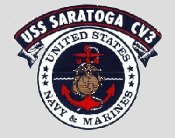
Courtesy of USS Saratoga Association

| Click on Thumbnail for Full Size Image |
Size | Image Description | Source | |
|---|---|---|---|---|
| World War II |
||||
| 1942 |
||||
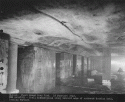 NS020368 |
46k | "On 11 January 1942, when heading towards a rendezvous with Enterprise, 500 miles southwest of Oahu, [Saratoga] was hit without warning by a deep-running torpedo fired by Japanese submarine, I-6. Although six men were killed and three firerooms were flooded, the carrier reached Oahu under her own power. There, her 8-inch guns, useless against aircraft, were removed for installation in shore defenses, and the carrier proceeded to the Bremerton Navy Yard for permanent repairs and installation of a modern antiaircraft battery." "Saratoga departed Puget Sound on 22 May for San Diego." (Text from DANFS, Dictionary of American Naval Fighting Ships. Saratoga was torpedoed by Japanese submarine I-6, but DANFS incorrectly mentions I-16). NS020368:Puget Sound Navy Yard photo #641-42, 18 February 1942. Shell indentations along inboard edge of outboard docking keel, looking forward. NS020368a:Puget Sound Navy Yard photo #646-42, 18 February 1942. Upper blister damaged area in way of temporary patch; looking forward. NS020368b:Puget Sound Navy Yard photo #648-42, 18 February 1942. Upper blister in way of after end of temporary patch. Read "U.S.S. Saratoga (CV3) - Final Report on War Damage," at the Researcher @ Large web site. |
Tracy White, Researcher @ Large | |
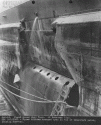 NS020368a |
63k | |||
 NS020368b |
64k | |||
 NS020343 |
42k | At Puget Sound on May 14, 1942 following repairs after being torpedoed by the Japanese submarine I-6 (LCDR Inaba) off Hawaii, January 11. Her new silhouette is evident. The twin 8" gun mounts have been replaced by twin 5"/38 mounts. She's finally received the wider forward flight deck and the lengthened after flight deck first envisaged as early as 1936. A British-style open bridge (a standard modification to US warships at that time) has been built atop the flag plot. The tripod foremast has been replaced by a light pole. The stack has also been lowered. She's also received a pair of Mk-37 5" directors, with Mk-4 radars, and a secondary air search radar (SC) at the after end of the stack. Note barrage balloon overhead. (USN photo.) |
Robert Hurst | |
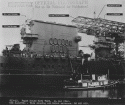 NS020343a |
87k | Puget Sound Navy Yard, 14 May 1942. View of USS Saratoga (CV-3), showing all radar antennas. Source: NARA San Francisco, Pearl Harbor Navy Yard General Correspondence Files, 1941–45. |
Tracy White, Researcher @ Large | |
 NS020343i |
147k | Additional photos of USS Saratoga (CV-3) at Puget Sound, 14 May 1942, following repairs after being torpedoed by the Japanese submarine I-6 (LCDR Inaba) off Hawaii, 11 January. Puget Sound Navy Yard photos. |
Ed Zajkowski | |
 NS020343g |
136k | |||
 NS020343d |
136k | |||
 NS020343e |
122k | |||
 NS020343f |
129k | |||
 NS020343h |
151k | |||
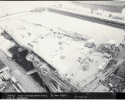 NS020343j |
172k | |||
 NS020343b |
81k | |||
 NS020343c |
75k | |||
 NS020307 |
288k | USS Saratoga (CV-3) alongside Naval Air Station, Ford Island, in Pearl Harbor, Territory of Hawaii, circa June–July 1942. Her original 8" guns and mounts had been removed in January that year, at Pearl Harbor, just after she was torpedoed off Hawaii on 11th January. She was rebuilt at PSNS with 5"/38s in twin mounts, and returned to active duty on 22 May 1942. Both her 8" guns and those from the USS Lexington (CV-2) became shore defense weapons in Hawaii. Official US Navy photograph, now in the collections of the National Archives and Records Administration (NARA), # 80-G-K-456. |
Bob Canchola, BT, USN (Ret.) | |
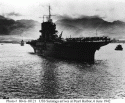 NS020357 |
110k | USS Saratoga (CV-3) arrives at Pearl Harbor from the U.S. West Coast, 6 June 1942. She departed the following day to join USS Enterprise (CV-6) and USS Hornet (CV-8) near Midway, bringing replacement aircraft for those two ships, whose air groups had been depleted during the Battle of Midway. Official U.S. Navy Photograph, now in the collections of the U.S. National Archives (# 80-G-10121). |
Paul Rebold | |
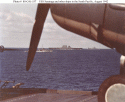 NS020358 |
68k | Carrier task force at sea, photographed from USS Enterprise (CV-6) in August 1942, during the Guadalcanal Campaign. USS Saratoga (CV-3) is in the center, with a Farragut-class destroyer to the left and a New Orleans-class heavy cruiser to the right. Official U.S. Navy Photograph, now in the collections of the U.S. National Archives (# 80-G-K-557). |
Paul Rebold | |
 NS020383 |
55k | The aircraft carriers USS Saratoga (CV-3) (foreground) and USS Enterprise (CV-6) underway, circa August 1942, with aircraft spotted for launch. U.S. Navy National Museum of Naval Aviation photo (#1996.448.012.019). |
Robert M. Cieri | |
 NS020319 |
35k | Wartime photo. Date and place unknown (might have been taken in August 1942, during the Guadalcanal campaign). |
Submitted by Clint Wingrove from the collection of his grandfather Joseph L. Wingrove. BM/2c. USN, USS Phoenix CL-46, 1939-45 | |
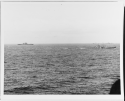 NS0203bb |
416k | Guadalcanal Campaign, August 1942–February 1943. Landing operations continue on USS Saratoga (CV-3), at left, in the late afternoon of 21 August 1942, while ships of the task force which escorted troops into the Solomons patrol off Guadalcanal. This was three days before the Battle of the Eastern Solomons. USS Atlanta (CL-51) is at right, with two heavy cruisers and some destroyers in the distance. Photographed from USS Enterprise (CV-6). Official U.S. Navy Photograph, now in the collections of the National Archives and Records Administration (NARA), # 80-G-74487. |
Gerd Matthes, Germany | |
 NS020344a |
323k | USS Saratoga (CV-3) torpedoed, 31 August 1942. Japanese postcard. Note that Sara was actually torpedoed by IJN submarine I-26, a Type B1 boat. Destroyers USS Phelps (DD-360), USS Macdonough (DD-351), and USS Monssen (DD-436) dropped depth charges and mistakenly claimed to have sunk the submarine—on 13th November it finished off the already damaged light cruiser USS Juneau (CL-52). I-26 was finally lost in October 1944 to an undetermined cause, either an operational accident or a Hedgehog attack by destroyer escort USS Richard M. Rowell (DE-403). |
Arnold Putnam | |
 NS020344 |
50k | USS Saratoga (CV-3) on September 8, 1942 listing at 9.5° whilst under repair at Tongatabu, after being torpedoed by the Japanese submarine I-26 (LCDR Yokota) on August 31. |
Robert Hurst | |
 NS020305 |
169k | Underway on September 17, 1942, en route to Pearl Harbor and permanent repairs. Saratoga had been hit by a Japanese submarine torpedo on August 31, in the Solomons, and made temporary repairs in Makualofa Harbor, Tongatabu Island. | USN | |
 NS020311 |
422k | USS Saratoga (CV-3) underway at sea, circa 1942. Planes on deck include five Grumman F4F fighters, six Douglas SBD scout bombers and one Grumman TBF torpedo plane. Official U.S. Navy Photograph, now in the collections of the National Archives (photo # 80-G-K-459). |
Scott Dyben David Wright |
|
 NS020376 |
257k | Saratoga – CV 3. From U.S. Naval Ships & Aircraft (ONI 54-R), condensed and printed for FM 30-50, NAVAER 00-80V-57 (Recognition Pictorial Manual of Naval Vessels). Supplement 2 - 19 November 1942. (See NS020343.) |
Gerd Matthes, Germany Mike Green |
|
 NS020376a |
277k | |||
| 1943 |
||||
 NS020330 |
587k | The carrier USS Saratoga (CV-3) is shown sometime in 1943, location unknown. Note that the twin 8 in (203 mm) guns have been replaced by twin 5 in/38 (127 mm) DP gun mounts, and the light AA armament has been considerably reinforced by numerous 40 mm and 20 mm guns. |
Robert Hurst Ed Zajkowski |
|
 NS020345 |
90k | USS Saratoga (CV-3) at anchor circa 1943, location unknown. |
Robert Hurst | |
 NS0203aw |
710k | USS Saratoga (CV-3) photographed from the flying control position of HMS Victorious during a lull in flying operations. This image was probably taken during exercises in June 1943, which also included cross-decking operations; six Avengers and twelve Martlets (British name for USN's Wildcat) from Victorious were exchanged for twelve F4F-4 Wildcats, eight TBF-1 Avengers and six TBD Dauntless of Carrier Air Group 3. Flying from both ships went smoothly and without incident. From The British Pacific Fleet: The Royal Navy's Most Powerful Strike Force, by David Hobbs (photo from author's collection). Published by Seaforth Publishing. |
Robert Hurst | |
 NS020312 |
87k | Grumman F6F-3 Hellcat fighters on the flight deck, as a TBM torpedo plane approaches to land, circa 1943-44. Photographed by Commander Edward Steichen, USNR. Note open elevator well in the foreground and flight deck crewmen chocking wheels of the F6Fs. Official U.S. Navy Photograph, now in the collections of the National Archives (photo # 80-G-K-15300). |
Scott Dyben | |
 NS020395 |
141k | Captain, later Admiral, John H. Cassady (USNA 1919) was commanding officer of USS Saratoga (CV-3) between August 1943 and June 1944. Portrait sketched at sea by LT G.B. Richardson and signed by CAPT Cassady for CDR Joseph C. Clifton, Sara's Air Group commander in 1944. |
Bill Gonyo | |
 NS0203aa |
108k | Commander, later Rear Admiral, Joseph Clinton ("Jumping Joe") Clifton (USNA 1930) was commanding officer of VF-12 in 1942–44, flying F4U Corsairs, and later F6F Hellcats from USS Saratoga (CV-3). In 1944 he commanded Saratoga's Air Group 12. NS0203aaa: Commander Joseph C. Clifton of VF-12 in his F6F-3 Hellcat about to be launched from Saratoga in 1944 during flight operations. Photo courtesy of LIFE magazine. |
Bill Gonyo | |
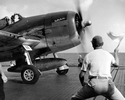 NS0203aaa |
168k | |||
 NS0203aab |
910k | Group photograph of the pilots of Fighting Squadron (VF) 12 pictured in front of an F6F-3 Hellcat at Pearl Harbor, Hawaii, 1943. The squadron skipper, Lieutenant Commander Joseph C. "Jumpin' Joe" Clifton, is pictured ninth from the left in the front row. VF-12 received the Navy's first F4U-1 Corsairs in October 1942, but was required to exchange them for F6F Hellcats before the squadron deployed aboard USS Saratoga (CV-3) in August 1943. CDR Clifton commanded the VF-12 "Peg Legs" (aka "Corsairs" and "Thunderbirds") from Saratoga and Guadalcanal between 1942 and 1944. U.S. Navy Photo. |
Bill Gonyo | |
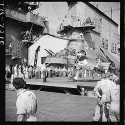 NS020359 |
113k | Plane parker signaling to pilot of F6F aboard USS Saratoga (CV-3), November 1943. National Archives photo # 80-G-470922. |
Tracy White, Researcher @ Large | |
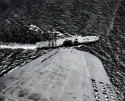 NS0203an |
2.65M | Aerial view of USS Saratoga (CV-3) en route to Rabaul Island, November 1943. Photographed by Lieutenant Wayne Miller, TR-8221. National Archives and Records Administration (NARA), photo # 80-G-470815. |
NARA, via Bob Canchola, BT, USN (Ret.) |
|
 NS020373 |
101k | Kenneth Bratton is pulled out of the gun turret of Air Group Commander Henry H. Caldwell's TBF Avenger by LT Julius "Julie" Briscoe, after raid on Rabaul, 5 November 1943. Photographer Paul Barnett was killed on the flight. Photo by LT Wayne Miller. |
Pieter Bakels | |
 NS020373a |
194k | Commander Joseph C. Clifton, USN, passes out cigars aboard USS Saratoga (CV-3), in celebration of a successful air attack on Rabaul, 5 November 1943. National Archives and Records Administration (NARA) photo, # 80-G-417635. |
NARA | |
| 1944 |
||||
 NS020328 |
114k | "Aircraft Carrier Saratoga." (From a Russian publication). This drawings show Saratoga after repairs at Pearl Harbor in September-October 1942 (top) and after a summer 1944 Puget Sound refit (middle and bottom). At Pearl Harbor her last 1.1-inch quad mounts were replaced by quad 40-mm Bofors (for a total of nine such weapons), and the number of single 20-mm Oerlikons was increased to 52. At Puget Sound the antenna of her main air search radar (SK) was moved to the foremast and replaced on the forward end of the stack by a fighter-director set (SM); she was also fitted with two H-2 hydraulic catapults. |
Alex Tatchin | |
 NS020385 |
89k | These photographs, taken at Hunters Point on 2 January 1944 after a refit, show the density of Saratoga's new light AA battery, increased at the request of her commanding officer. |
Ed Zajkowski | |
 NS020385a |
92k | |||
 NS020346 |
54k | USS Saratoga (CV-3) tied-up at Hobart, Tasmania, mid-March 1944. |
Robert Hurst | |
 NS020370 |
76k | USS Saratoga (CV-3) (middle distance) along with the fleet carrier HMS Illustrious and other major British naval units at Trincomalee, or 'Trinco', in Ceylon (today Sri Lanka), April 1944. At this time Saratoga was operating with the Royal Navy against targets in Sumatra (IWM A23475). Photo from "The Fleet Air Arm Handbook," by David Wragg. |
Robert Hurst | |
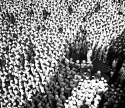 NS020360 |
317k | Admiral Lord Louis Mountbatten, RN, (center) addresses personnel aboard USS Saratoga at Trincomalee, Ceylon, April 30, 1944. Photo by LT Wayne Miller. National Archives photo # 80-G-470720. |
Michael Mohl | |
 NS020360a |
647k | Rear Admiral Louis Mountbatten (left) and Captain John Howard Cassady, skipper of USS Saratoga (CV-3), pictured aboard the carrier, 30 April 1944. This image is part of a photograph album kept by Commander Joseph C. Clifton during 1942–1944, which included service as Commanding Officer of Fighting Squadron (VF) 12 and Commander Air Group (CAG) 12. Photo courtesy of the National Naval Aviation Museum. |
Bill Gonyo | |
 NS0203ag |
88k | After serving with HMS Illustrious (87), as part of the British Far Eastern Fleet, USS Saratoga (CV-3) is underway on 18 May 1944 and is passing down the columns of the Eastern Fleet as the Allied ships rendered honors to and cheered to each other. Imperial War Museums, Admiralty Official Collection, by Trusler, C. (Lt), Photo # ©IWM (A 24268). |
Mike Green | |
 NS020396 |
245k | USS Saratoga (CV-3) underway at sea on 30 May 1944. Australian War Memorial photo (# 106031). |
Mike Green | |
NS0203af |
12.8M | USS Saratoga (CV-3), Booklet of General Plans, August 1944. |
Courtesy of the San Francisco Maritime National Park Association,
via Curtis Tammany |
|
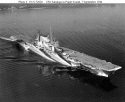 NS020314 |
93k | USS Saratoga (CV-3) in Puget Sound, Washington, following overhaul, 7 September 1944. Note her unique camouflage scheme, Measure 32 Design 11A. By this time she had been fitted with numerous 40-mm/56-cal Bofors mounts. The Mk.37 directors were now equipped with Mk.12/22 radars. Photograph from the Bureau of Ships Collection in the U.S. National Archives (# 19-N-72626). (Thanks to Robert Hurst, who provided additional info). |
NHC | |
 NS020314b |
125k | As above. |
Steve Whitby | |
 NS020314a |
165k | As above. National Archives photo. |
Steve Whitby | |
 NS020314c |
156k | As above. |
Steve Whitby | |
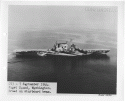 NS020314d |
94k | As above. "CV3 [USS Saratoga] - 7 September 1944. BuAer photo # 180790. |
David Buell | |
 NS020314e |
530k | As above. |
David Buell | |
 NS020314e1 |
99k | Same photo as above, colorized by Yu Chu. |
Yu Chu | |
NS020314f |
99k | As above. |
USN | |
 NS020314f1 |
108k | Same photo as above, colorized by Yu Chu. |
Yu Chu | |
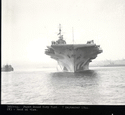 NS020314g |
489k | As above. "3215-44. Puget Sound Navy Yard. 7 September 1944. |
Ed Zajkowski | |
 NS020314h |
137k | As above. US Navy photo. |
David Buell | |
 NS020314i |
869k | As above. "3217-44. Puget Sound Navy Yard. 7 September 1944. |
Ed Zajkowski | |
 NS020336 |
131k | "Dawn Strike". USS Saratoga (CV-3) in Measure 32, Design 11A camouflage after having launched a strike against Formosa, 1944. Painting by Wayne Scarpaci, 18"x24". |
©Wayne Scarpaci | |
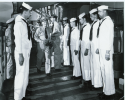 NS0203bq |
429k | A subcommittee of the House Naval Affairs Committee and ADM Nimitz were aboard USS Saratoga (CV-3) when she went out from Pearl Harbor for training on 9 December 1944. NS0203bq: ADM Nimitz arrives aboard Sara. NS0203bqa: Front row, left to right: Unknown; ADM Chester W. Nimitz; Congresswoman Margaret Chase Smith (R-ME); Ingram M. Stainback (?), Territorial Governor of Hawaii; ADM Raymond A. Spruance. |
Collection of RADM Theodore R. Frederick, via Edwin Kaukali |
|
 NS0203bqa |
218k | |||
 NS0203as |
80k | "The large American aircraft carrier Saratoga, launching TBF Avenger topedo planes late in the war. Although the oldest U. S. Navy carrier afloat, the Saratoga, which displaced 33,000 tons, was still the largest. Converted from a battle cruiser in the early 1920s, she carried 100 aircraft and was originally armed with eight 8-inch guns; however, by the end of the conflict these were replaced by smaller, but more useful, 5-inch guns." Photo and text from The Naval Air War, 1939–1945, by Nathan Miller, p.70. |
Via Tommy Trampp | |
| 1945 |
||||
 NS0203bp |
450k | USS Saratoga (CV-3), apparently at Alameda, California, date unknown. Note district harbor tug, small, YTL-434 (?) and covered lighter YF-710 close to Sara, and stern of a Casablanca-class escort carrier in the right background. |
Sally & Penny Bronken, daughters of Paul Bronken, USS Puget Sound (CVE-113), and Hugh K. Telleria, son-in-law | |
 NS020397 |
168k | USS Saratoga (CV-3), wartime image, exact date and location unknown, ©Liberty Picture Co. 1945. . |
Tommy Trampp | |
 NS0203ae |
91k | USS Saratoga (CV-3) after sustaining multiple kamikaze hits, February 1945. . |
Bob Canchola, BT, USS Oriskany 1971–1973 |
|
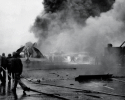 NS0203aea |
461k | Battling flames on the flight deck of USS Saratoga (CV-3) caused by five kamikaze hits, 21 February 1945, near Chichi Jima. . |
Bob Canchola, BT, USS Oriskany 1971–1973 |
|
| Kamikaze attack off Iwo Jima, 21 February 1945 — The Harold C. Cassar Photo Collection |
||||
NS020302 |
14k | USS Saratoga (CV-3) underway in May 1945, after her final refit. Note tall radar mast and sleek cruiser lines. Her after elevator has been removed and a new, larger forward elevator has replaced the old T-shape lift. The hull bulge is also clearly visible. Her radar suite comprises SG and SK on the pole mast, SM on the forward edge of the funnel and SC-4 on the after edge. She is wearing Measure 21 camouflage. (Thanks to Robert Hurst, who provided additional info). | USN | |
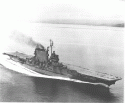 NS020302a |
131k | David Buell | ||
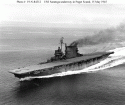 NS020326 |
105k | USS Saratoga (CV-3) running full power trials in Puget Sound, Washington, following battle damage repairs, 15 May 1945. Photograph from the Bureau of Ships Collection in the U.S. National Archives (photo # 19-N-84312). |
NHC | |
 NS020347 |
66k | USS Saratoga (CV-3) underway on a high-speed run in Puget Sound after her last, post-kamikaze refit, May 15, 1945. The aft aircraft lift was removed and the aft section of the hangar divided up into numerous accommodation rooms in preparation for transporting troops home during Operation Magic Carpet (USN photo). |
Robert Hurst | |
 NS020361 |
322k | Official USN Photograph, via National Archives and Records Administration (NARA), # 80-G-K-14568, id. 178141130. USS Saratoga (CV-3) is shown at Ford Island in Pearl Harbor. Date is about June 1945. |
David Buell David Upton |
|
 NS0203am |
2.89M | The first photographs of the February 1945 kamikaze attack on USS Saratoga (CV-3) were made public in June. Detroit Times, 16 June 1945. |
Chronicling America, via Michael Mohl |
|
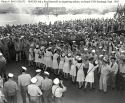 NS020389 |
438k | Mass "Aloha" on USS Saratoga's flight deck, at Pearl Harbor, 10 September 1945, as 500 WAVES put leis around the necks of departing Sailors in traditional Hawaiian style. A resounding kiss sped each man on his way. Saratoga was transporting Navy personnel back to the mainland for discharge. Official U.S. Navy Photograph, now in the collections of the National Archives (# 80-G-351675). |
Courtesy of Scott Koen & ussnewyork.com | |
 NS020632 |
116k | Naval Air Station, Alameda, California — Four aircraft carriers docked at the Air Station's piers, circa mid-September 1945. The ships are (from front to back): USS Saratoga (CV-3), USS Enterprise (CV-6), USS Hornet (CV-12) and USS San Jacinto (CVL-30). Note PBY amphibians parked at the far left. Official U.S. Navy Photograph, now in the collections of the National Archives (photo # 80-G-701512). Note that four, out of five, classes of fast Aircraft Carriers that fought in the Pacific (only the one-ship class Wasp is missing) are represented in this photograph. |
NHC | |
 NS020348 |
68k | USS Saratoga (CV-3) in the autumn of 1945, showing her flight deck crowded with returning GIs from the Pacific. She is painted in Measure 21. Note the hull bulge is clearly visible. (USN photo.) |
Robert Hurst | |
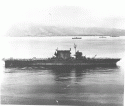 NS020362 |
136k | USN photo of USS Saratoga (CV-3), undoubtedly taken after her last wartime refit, and possibly during one of her Magic Carpet runs. |
David Buell | |
 NS020371 |
190k | USN official photo of USS Saratoga (CV-3), USN # 495981, U.S. Naval Station Washington D.C., released in January 1946. Original caption reads: "The USS Saratoga (CV-3) enroute to the States with about 30,000 [sic] veterans aboard. This is her last [Magic Carpet] trip as a transport." |
David Buell | |
 NS0203ak |
1.32M | "My stepfather, William H. Carroll [...] returned to San Francisco on the Sara shortly after the Japanese War ended. He was an EM1C with the 56th Sea Bees and served over two years in Hawaii and Guam. [This is] his copy of the ladder locations aboard the ship." |
Frank Ward | |
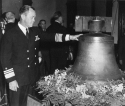 NS0203at |
90k | Vice Admiral Gerald Francis Bogan in a moment of contemplation at the Saratoga celebration. Photo courtesy of the San Diego Air & Space Museum. |
Bill Gonyo | |
| Bikini Atomic Bomb Tests, 1946 |
||||
 NS020363 |
149k | San Francisco Naval Shipyard photo # 578-46-S8, taken at the Naval Air Station, Alameda, on February 27, 1946 while Sara was being prepared for use as a target at Bikini. Note the missing #4 5"/38 mount as well as the other missing 5" and 40mm from the gun tubs, as well as some gun directors. Another interesting aspect of this photo is that is shows three CVLs in the background. These are Belleau Wood (CVL-24), which reported for inactivation on January 31, after her third and final Magic Carpet run; and probably Cowpens (CVL-25) and San Jacinto (CVL-30). These three light carriers joined the Pacific Reserve Fleet. All other surviving CVLs were placed in reserve at Philadelphia after World War II except Independence (CVL-22) which also went to Bikini as a target. |
David Buell | |
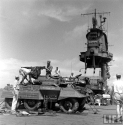 NS0203ay |
267k | Starboard flight deck view looking forward of USS Saratoga (CV-3) being prepared as a target vessel for the Crossroads atomic bomb tests at Bikini Atoll in the Pacific Ocean, 1946. The vehicles, guns, and wing sections were installed for the testing. LIFE magazine, Fritz Goro Photographer, shared by Peter DeForest. |
Mike Green | |
 NS020398 |
162k | This photo appears to have been taken on 1 May 1946, when Saratoga departed San Francisco for the last time, bound for Pearl Harbor and then on to Bikini Atoll and Operation Crossroads. |
reddit, via Timothy Choi, used with permission | |
 NS013436c |
1.40M | Nevada (BB-36), colored orange, with New York (BB-34) and other major vessels, including Saratoga, listed in the table at the bottom of the photo. National Archives and Records Administration (NARA), Record Group 374: Records of the Defense Threat Reduction Agency, 1943 – 2005 Series: Photographs of Atmospheric Nuclear Testing at Pacific Island and Nevada Test Sites, 1946&ndah;1962. Project 18 – Operation Crossroads (Bikini) Test Activities, National Archives Identifier: 146763102. Local Identifier: 374-ANT-18-CR-553-14. |
NARA, via Yu Chu | |
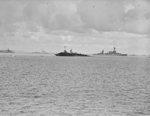 NS013446s |
741k | Saratoga (CV-3) going down at 1540 Baker Day in Bikini Lagoon during Operation Crossroads, 25 July 1946. New York (BB-34) appears off to the right. National Archives and Records Administration (NARA) photo, NARA id. 520999, local identifier 80-G-627506. |
NARA, via Daniel Hacker | |
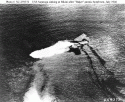 NS020308 |
182k | Ex-USS Saratoga (CV-3) sinking in Bikini Lagoon after she was fatally damaged by the "Baker Day" underwater atomic bomb test, 25 July 1946. Note her hull number ("3") still visible at the front of her flight deck, air escaping from her submerged hull and oil streaming away to starboard. NHC photo # SC 259372 (Photograph from the Army Signal Corps Collection in the U.S. National Archives). |
Michael Mohl | |
 NS020333 |
256k | "The gallant carrier Saratoga, survivor of the air-burst Bikini bomb, slowly settles to the bottom after the under-water burst." |
EMC(SW) Brian Kroenung | |
 NS020333a |
392k | Although the Navy mounted an extraordinary effort to save USS Saratoga (CV-3), the warship was too contaminated to conduct extensive damage control procedures and she eventually sank. One of the legends of the Pacific war, her loss was keenly felt by the officers and men of Operation Crossroads. Painting, Watercolor on Paper, by Arthur Beaumont, 1946. Unframed Dimensions 18H x 23W. Naval History and Heritage Command, accession # 88-169-G. |
Courtesy of Scott Koen & ussnewyork.com | |
 NS020333b |
44k | USS Saratoga (CV-3) quietly slipped below the waves, eventually resting upright on the bottom of the lagoon where she could be seen from the surface. Painting, watercolor on illustration board, by Grant Powers, 1946. Unframed Dimensions 13H X 17W. Naval History and Heritage Command, accession # 88-181-Q. |
||
 NS0203bf |
148k | "U.S.S. Saratoga (CV-3) at Bikini Atoll, U.S. National Park Service, Submerged Cultural Resources Unit" |
Ron Reeves | |
 NS020390 |
126k | Photos of old Sara as she is now (2014), taken by Stephen W. Hubbard, who comments: "The ship is quite dangerous and collapsing. While we where there this year, a major portion of the hangar deck collapsed (see photos)." This is the cockpit of a Helldiver. |
Stephen W. Hubbard, MD | |
 NS020390a |
91k | The following day, a portion of the hangar overhead had collapsed over the cockpit. |
||
 NS020390b |
1.01M | A haunting view of the bridge. |
||
 NS020390c |
610k | Bow of Sara. |
||
 NS020390d |
799k | Island of Sara. |
||
 NS020390e |
556k | View of the island and forward elevator shaft. |
Stephen W. Hubbard, MD | |
 NS020390f |
700k | Looking forward from abaft the island and anti-aircraft battery. |
||
|
||||
| Main Photo Index |
Aircraft Carrier Photo Index Page |
Comments, Suggestions or Image submissions, E-mail Carrier Information
Problems and site related matters, E-mail Webmaster
This page was created by Timothy Dike and is maintained by Fabio Peña
![]()
Last update: 8 February 2025